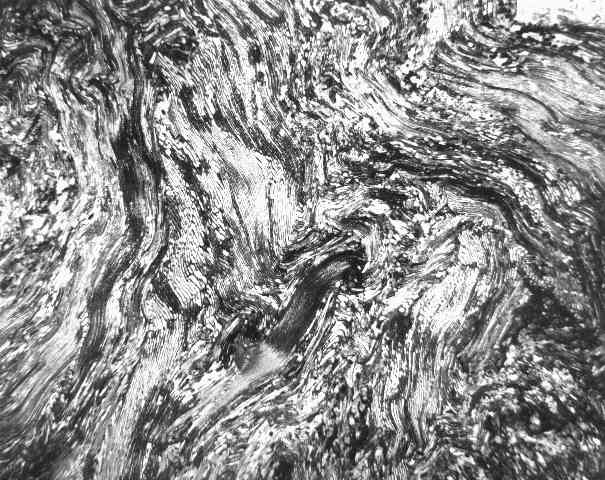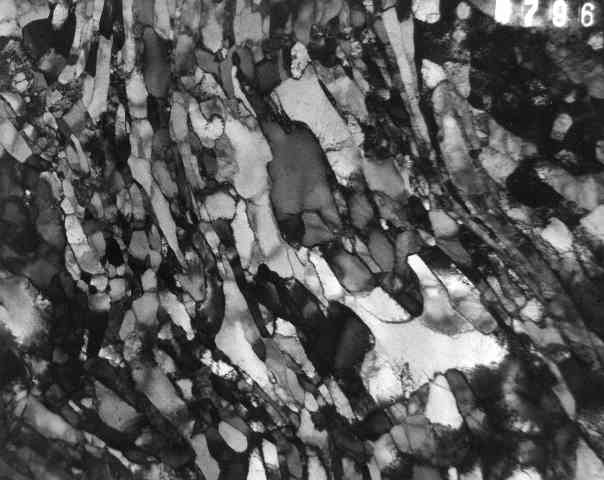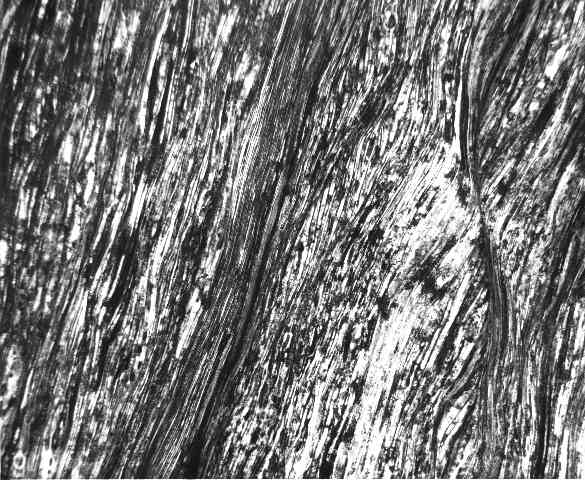"What do arn &
steel wire look like ?" you may ask ...
Return
to georgesbasement
The pictures below were all made with transmission electron
microscopes at the U.S. Steel Fundamental Research Laboratory (now defunct,
sadly) in Monroeville, Pennsylvania. The magnifications are about 10,000
times at the original image size of three by four inches. They're about
2-1/2 times that on an SVGA screen. The specimens were made transparent
to electrons (1/10000 millimeter thick) by electropolishing. I owe a great
deal to Dick Glenn for teaching me how to make thin foils like these, and
I thank Chuck Spangler and Bob Sober for making the thin foils that are
pictured here.
 This
is piano wire, wire drawn to a true strain of 3.2. That means the wire
has been elongated to nearly twenty-five times its original length, its
diameter reduced by a factor of nearly five, and its strength increased
by a factor of square root five (2.24 times). Actually, this particular
example is a special one in which I caused the pearlite lamellae (layers
of soft ferrite and hard iron carbide) to be oriented nearly parallel to
the long axis of the wire. I did this by transforming the wire from austenite
(the high temperature phase used in the hardening of steel) to pearlite
progressively along the length of the wire by pulling the wire through
a steep temperature gradient. The picture shows a transverse section, looking
down the axis of the wire. Everything you see here is an end-on view of
a tiny fiber, either ferrite or iron carbide. The strange, swirly structure
is a consequence of the crystal structure of the ferrite, whose grains
want to be come ribbon-shaped as they are stretched. They don't fit together
very well that way, so the ribbons wrap around each other. The iron carbide
layers are trapped within the ferrite grains, so they get swirly too.
This
is piano wire, wire drawn to a true strain of 3.2. That means the wire
has been elongated to nearly twenty-five times its original length, its
diameter reduced by a factor of nearly five, and its strength increased
by a factor of square root five (2.24 times). Actually, this particular
example is a special one in which I caused the pearlite lamellae (layers
of soft ferrite and hard iron carbide) to be oriented nearly parallel to
the long axis of the wire. I did this by transforming the wire from austenite
(the high temperature phase used in the hardening of steel) to pearlite
progressively along the length of the wire by pulling the wire through
a steep temperature gradient. The picture shows a transverse section, looking
down the axis of the wire. Everything you see here is an end-on view of
a tiny fiber, either ferrite or iron carbide. The strange, swirly structure
is a consequence of the crystal structure of the ferrite, whose grains
want to be come ribbon-shaped as they are stretched. They don't fit together
very well that way, so the ribbons wrap around each other. The iron carbide
layers are trapped within the ferrite grains, so they get swirly too.
Click on the picture to get a high resolution view. This will
take a long time to load, but you can then use an image-editing program
to crop sections of the image to see or print them more clearly.
 This
is arn wire, drawn to a true strain of 4.0 (fifty-four times its original
length). It doesn't get strong as fast as piano wire, but it has the property
of work hardening essentially forever, at least to a true strain of ten
(twenty thousand times its original length). The rate of hardening is linear
in true strain, about 20,000 pounds per square inch for each unit of strain.
This is another consequence of the crystal structure of ferrite and its
tendency to want to become ribbon shaped as it elongates. The curly grain
structure isn't so evident here as it is in piano wire, because another
wonderful process called dynamic recovery causes the fibrous grains to
consume each other, so at the end there are fewer of the cell-like islands
seen here (all of the material inside each island is of the same crystaline
orientation) than there were grains in the original microstructure.
This
is arn wire, drawn to a true strain of 4.0 (fifty-four times its original
length). It doesn't get strong as fast as piano wire, but it has the property
of work hardening essentially forever, at least to a true strain of ten
(twenty thousand times its original length). The rate of hardening is linear
in true strain, about 20,000 pounds per square inch for each unit of strain.
This is another consequence of the crystal structure of ferrite and its
tendency to want to become ribbon shaped as it elongates. The curly grain
structure isn't so evident here as it is in piano wire, because another
wonderful process called dynamic recovery causes the fibrous grains to
consume each other, so at the end there are fewer of the cell-like islands
seen here (all of the material inside each island is of the same crystaline
orientation) than there were grains in the original microstructure.
Again, click on the picture to get the high-resolution version.
 Here
the strange stuff is oriented pearlite again, but this time elongated in
plane strain, which is similar to rolling, except that it uses a rectangular
die instead of rolls. The material is shaped like a ribbon and is elongated
by making the ribbon thinner and longer, but always keeping it the same
width. Again, the stuff confounds us by having an internal shape change
that only barely resembles what is going on outside. There are regions
of the metal which get thinner & longer OK, but the various regions
tend to slide past each other discontinuously. The boundaries of discontinuity
are called shear bands, and one of them in the above image has collapsed
into a shear crack, which ruins the strength and ductility of the product.
Let this be a lesson to the blacksmiths pounding on cold metal: if you
keep the stuff round while you stretch it, it will stay together a whole
lot better than if you flatten it as you stretch it. Done hot, the metal
doesn't have these limitations because the crystals keep reforming themselves
by a process called recystallization, which preserves the soft state of
the metal. The image above is an edge section, so you're looking across
the width of the strip.
Here
the strange stuff is oriented pearlite again, but this time elongated in
plane strain, which is similar to rolling, except that it uses a rectangular
die instead of rolls. The material is shaped like a ribbon and is elongated
by making the ribbon thinner and longer, but always keeping it the same
width. Again, the stuff confounds us by having an internal shape change
that only barely resembles what is going on outside. There are regions
of the metal which get thinner & longer OK, but the various regions
tend to slide past each other discontinuously. The boundaries of discontinuity
are called shear bands, and one of them in the above image has collapsed
into a shear crack, which ruins the strength and ductility of the product.
Let this be a lesson to the blacksmiths pounding on cold metal: if you
keep the stuff round while you stretch it, it will stay together a whole
lot better than if you flatten it as you stretch it. Done hot, the metal
doesn't have these limitations because the crystals keep reforming themselves
by a process called recystallization, which preserves the soft state of
the metal. The image above is an edge section, so you're looking across
the width of the strip.
As before, click on the image to get the high-resolution version.
Go
back to the top of this page
 This
is piano wire, wire drawn to a true strain of 3.2. That means the wire
has been elongated to nearly twenty-five times its original length, its
diameter reduced by a factor of nearly five, and its strength increased
by a factor of square root five (2.24 times). Actually, this particular
example is a special one in which I caused the pearlite lamellae (layers
of soft ferrite and hard iron carbide) to be oriented nearly parallel to
the long axis of the wire. I did this by transforming the wire from austenite
(the high temperature phase used in the hardening of steel) to pearlite
progressively along the length of the wire by pulling the wire through
a steep temperature gradient. The picture shows a transverse section, looking
down the axis of the wire. Everything you see here is an end-on view of
a tiny fiber, either ferrite or iron carbide. The strange, swirly structure
is a consequence of the crystal structure of the ferrite, whose grains
want to be come ribbon-shaped as they are stretched. They don't fit together
very well that way, so the ribbons wrap around each other. The iron carbide
layers are trapped within the ferrite grains, so they get swirly too.
This
is piano wire, wire drawn to a true strain of 3.2. That means the wire
has been elongated to nearly twenty-five times its original length, its
diameter reduced by a factor of nearly five, and its strength increased
by a factor of square root five (2.24 times). Actually, this particular
example is a special one in which I caused the pearlite lamellae (layers
of soft ferrite and hard iron carbide) to be oriented nearly parallel to
the long axis of the wire. I did this by transforming the wire from austenite
(the high temperature phase used in the hardening of steel) to pearlite
progressively along the length of the wire by pulling the wire through
a steep temperature gradient. The picture shows a transverse section, looking
down the axis of the wire. Everything you see here is an end-on view of
a tiny fiber, either ferrite or iron carbide. The strange, swirly structure
is a consequence of the crystal structure of the ferrite, whose grains
want to be come ribbon-shaped as they are stretched. They don't fit together
very well that way, so the ribbons wrap around each other. The iron carbide
layers are trapped within the ferrite grains, so they get swirly too.
